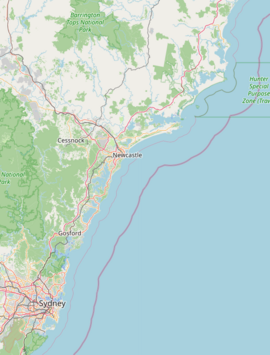Eleebana, New South Wales facts for kids
Quick facts for kids EleebanaGreater Newcastle, New South Wales |
|||||||||||||||
|---|---|---|---|---|---|---|---|---|---|---|---|---|---|---|---|
| Population | 6,460 (2021 census) | ||||||||||||||
| • Density | 1,656/km2 (4,290/sq mi) | ||||||||||||||
| Postcode(s) | 2282 | ||||||||||||||
| Area | 3.9 km2 (1.5 sq mi) | ||||||||||||||
| Location |
|
||||||||||||||
| LGA(s) | City of Lake Macquarie | ||||||||||||||
| Parish | Kahibah | ||||||||||||||
| State electorate(s) | Charlestown | ||||||||||||||
| Federal Division(s) | Shortland | ||||||||||||||
|
|||||||||||||||
Eleebana is a suburb in the City of Lake Macquarie. It is located in New South Wales, Australia. This area is about 18 kilometers (11 miles) from Newcastle's main city center. Eleebana sits along the eastern shore of the beautiful Lake Macquarie.
Contents
Discovering Eleebana's Past
Eleebana was not settled for a long time. This was because its land was not very good for farming. It became part of the growing city areas of Newcastle and Lake Macquarie much later.
Early Days and Land Use
In the past, the land in Eleebana was quite steep and poor. This made it hard to grow crops. Because of this, people did not build homes there for many years.
However, in the 1920s and 1930s, some people used the waterfront area. They built small boatsheds along Croudace Bay. These sheds were often used during the summer months for fun by the lake. Later, the local council worked to remove these sheds. Their locations eventually became part of Thomas H. Halton Park in Croudace Bay.
How Eleebana Grew
Eleebana really started to grow into a suburb later on. New housing areas were developed, especially to the north. In 1976, a company called Hooker-Rex Estates announced big plans. They wanted to build homes on a large area of land. This development included hundreds of new housing blocks. More homes were built in the late 1970s and early 1980s.
Modern Services Arrive
As more people moved to Eleebana, important services were added.
- In 1947, electricity came to the area.
- In 1948, clean tap water was connected to homes.
- The first school, Eleebana Public School, opened in 1955.
- In 1977, the sewerage system was connected.
These services helped Eleebana become the modern suburb it is today.


